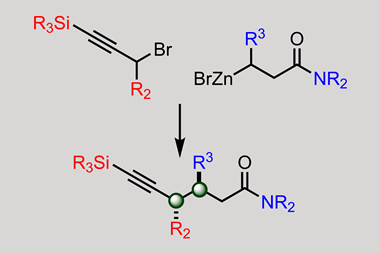Exploring nickel reactivity in C–H activation chemistry
Nickel has historically sat in the shadow of its big brother palladium, though in recent years its distinct reactivity has led to it stealing some of the limelight (almost literally) with impressive applications in photoredox catalysis and reductive cross-coupling chemistry. In contrast, palladium still reigns supreme for C–H activation chemistry, with nickel being plagued by the need for extreme temperatures (>130°C) and poor functional group tolerance.
In 2015, Melanie Sanford’s group at the University of Michigan, US, demonstrated a highly atypical Ni(iv) species that was able to mediate C(sp3)–O, –N and –S bond formation with reduction to Ni(ii) at room temperature.1 This proof of principle was far from demonstrating a viable catalytic Ni(ii)–Ni(iv) redox system and did not address the C–H activation step, but it offered hope for finding new reactivity using nickel.
The Sanford group has since shown room temperature C(sp2)–H activation using a similar highly electrophilic Ni(iv) species, though they were unable to demonstrate subsequent functionalisation of the activated bond.2 They proposed this was because the lack of a vacant coordination site on nickel prevented an inner sphere sp2 reductive elimination. Therefore, as they were striving to demonstrate catalytic turnover for a Ni(ii)–Ni(iv) redox cycle, they turned their attention to sp3 C–H functionalisation.3 For such a reaction, bond formation is presumed to proceed via an outer-sphere mechanism and therefore a vacant coordination site is not required.
The team began by treating a Ni(ii) complex with N-fluoro-2,4,6-trimethylpyridinium triflate (NFTPT) in dichloromethane, and observed room temperature activation of a C(sp3)–H bond in only 10 minutes. This formed a mixture of two Ni(iv) complexes in near-quantitative yield (figure 1). They went on to isolate the triflate and demonstrate its reactivity with NMe4F (figure 2), generating a new C–F bond in 36% yield with the major by-product being the previously observed fluorine complex that appears unreactive, presumably due to the poor leaving group ability of fluorine.
Further reactions with the Ni(iv) triflate species and oxygen, nitrogen, sulfur and carbon nucleophiles gave isolated products in high yield. Reaction rates were highly dependent on the nucleophilicity of the reagent, supporting the outer-sphere mechanistic proposal. The most interesting product came from reaction with a chloride nucleophile, as a subsequent intramolecular quaternisation of the pyridine ligand/substrate provided an excellent opportunity to demonstrate catalytic turnover.
Having demonstrated the critical elementary steps – oxidative mediated C–H activation and reductive functionalisation – the team suggested that the pyridinium product from the reaction with chloride should be less chelating than the bipyridine starting material, and therefore offered the potential for ligand exchange and catalytic turnover. In addition, the chloride anion could potentially displace fluoride if the ‘unproductive’ fluoride species is formed, and prevent irreversible formation of the catalytically unproductive species. With some optimisation, the team showed that following dropwise addition of NFTPT to the reaction mixture, they were able to form the product in 76% NMR yield with 20 mol% of catalyst. This gives a turnover of just under four, meaning that a mole of the catalyst can convert four moles of substrate before it inactivates (figure 3).
Although a turnover of four is not anything to write home about, and the carefully designed substrates are certainly not giving interesting products, Sanford and her colleagues have again shown that careful study of fundamental reactivity can open the door to untold future potential. In a time where academics are judged as much on throughput as content, work that highlights a true commitment to understanding reactivity should be praised.
References
1 N M Camasso and M S Sanford, Science, 2015, 347, 1218 (DOI: 10.1126/science.aaa4526)
2 E Chong et al, J. Am. Chem. Soc., 2017, 139, 6058 (DOI: 10.1021/jacs.7b02387)
3 C C Roberts et al, J. Am. Chem. Soc., 2019, 141,19513 (DOI: 10.1021/jacs.9b11999)















No comments yet